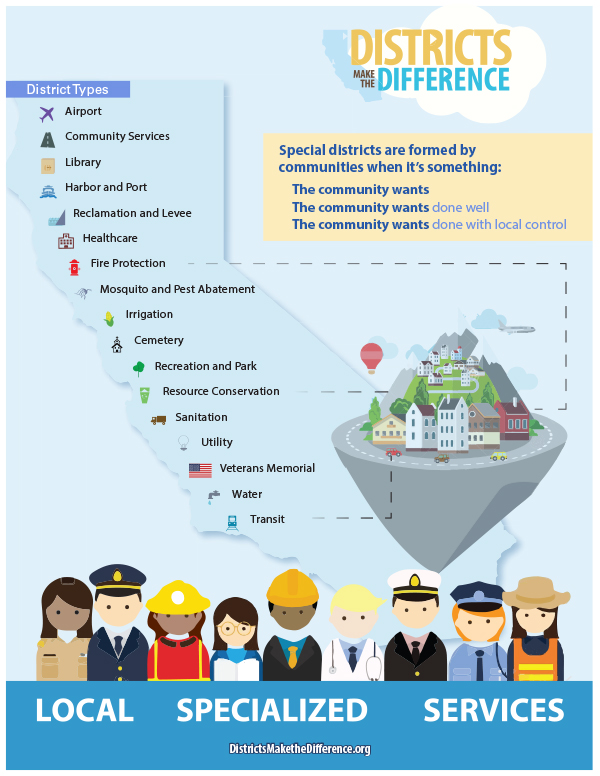By Chris Finnie
Special districts are a form of local government created by a local community to meet a specific need. When residents or landowners want new services or higher levels of existing services, they can form a district to pay for and administer them. Special districts may cross city and county boundaries, and like other government entities, they are governed by a board of directors.
According to the California Special District Association, there are approximately 2,300 independent special districts in California that deliver a wide variety of services from airports to water, mosquito abatement to fire protection. Most special districts serve just a single purpose, such as sewage treatment. To deliver these services, special districts enjoy many of the same governing powers as cities and counties. They can enter into contracts, employ workers, and acquire real property through purchase or eminent domain. They can also issue debt, impose taxes, levy assessments, and charge fees for their services.
State Oversight and Regulation They are autonomous government entities, accountable only to the voters or landowners they serve. State government, how-ever, oversees special districts in several ways. For example, special districts have to submit annual financial reports to the State Controller and must also follow state laws on public meetings, bonded debt, re-cord-keeping, and elections.
This means that the public has a right to inspect public records during office hours, and to request and obtain copies of records, though there can be a fee. Exemptions to this rule can include documents protected by attorney-client privilege, and personnel records.
The Brown Act requires that meetings be open to the public, allow for public comment, and be publicly noticed 72 hours in advance of the meeting. It contains procedures for conducting special meetings, emergency meetings, and closed sessions. The Brown Act also limits the ability for a quorum of a legislative body to discuss certain matters outside a noticed public meeting.
Another law requires local elected officials to take ethics training courses once every two years.
Under the Sustainable Ground-water Management Act of 2014, Santa Cruz County is working with local water agencies to pursue sustainability for the three major groundwater basins in the county and has formed Joint Powers Agencies to man-age them.
In addition, cities, counties, and special districts each pay one-third of the costs of the local agency formation commission (LAFCo). A given district’s contribution is proportionate to the district’s revenue. According to Patrick McCormick, Executive Officer of the Santa Cruz County LAFCo, has agency has two roles in special districts: They regulate boundaries and service areas. For example, when Felton and Lompico joined SLVWD, LAFCo had public meetings and issued a report. They also review the services that districts are providing and make suggestions for improvement. However, he notes that, like the county grand jury, LAFCo has no ability to actually regulate special districts. McCormick also adds that, “In California, water districts are subdivisions of the state,” and that the State Water Resources Control Board regulates things like water quality. In addition, the Santa Cruz County LAFCo only has a two-person staff.
Citizen Oversight In addition to requesting in-formation, attending meetings, and offering comments—and, of course, voting for board members—local voters have some legislative options to exercise more direct control of special districts:
Citizens can propose ordinances directly by using initiatives. To do this, the proposed ordinance has to be submitted to the governing board of the district by an initiative petition filed with the district elections official. Proponents then need to publish a notice of intention, and finally, circulate a petition for signatures by people who are qualified to vote in the district.
Referenda also gives citizens a direct vote in district matters. The referendum power lets citizens put recent board actions on the ballot and reject them before they go into effect. Referendum procedures are similar to the initiative process. The recall power allows voters to remove board members from office before the next election. Elected board members may be relieved of their duties by a process similar to those for initiatives and referendums.
For more information, visit https://www.csda.net/special-dis-tricts/learn-about/


